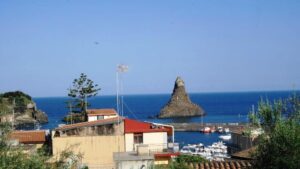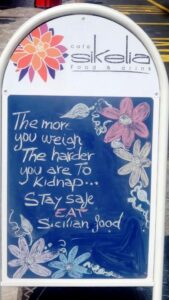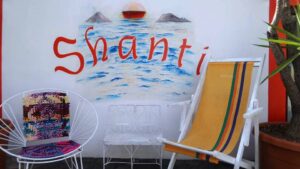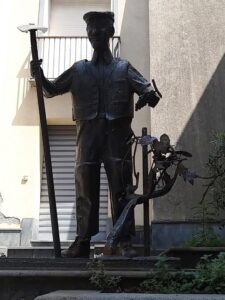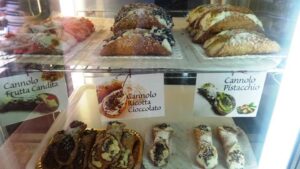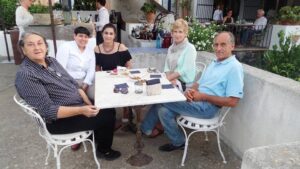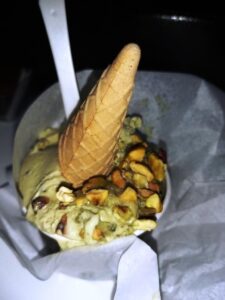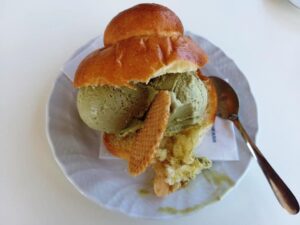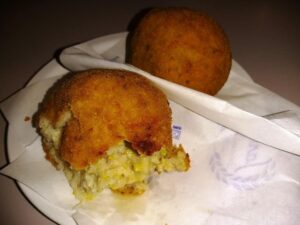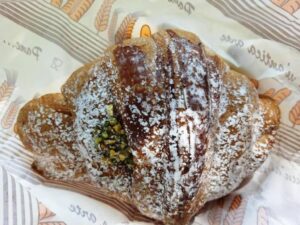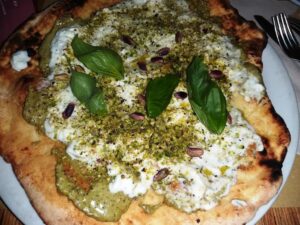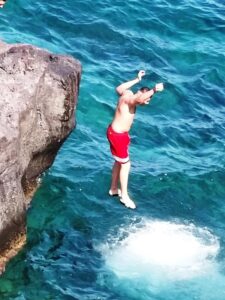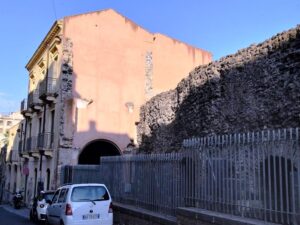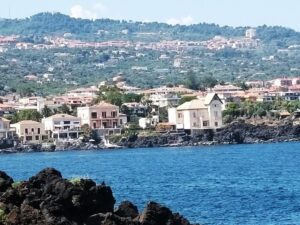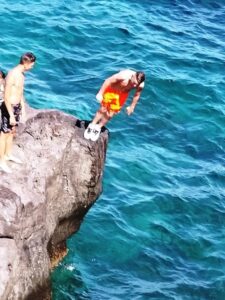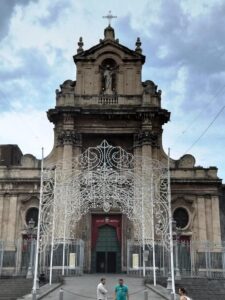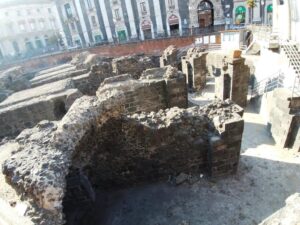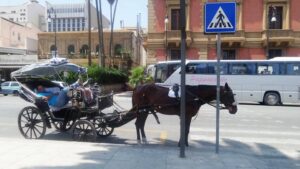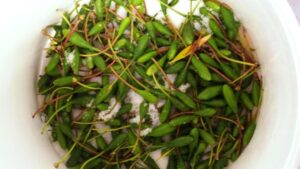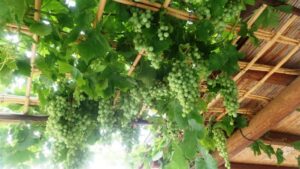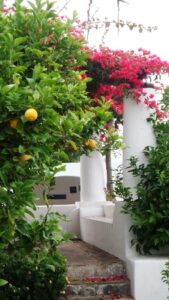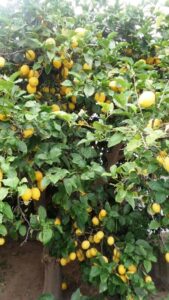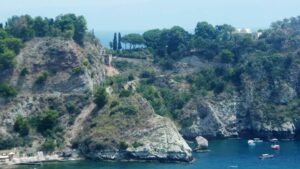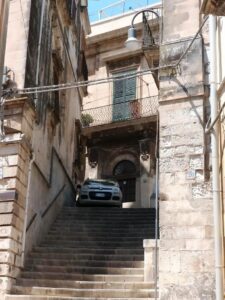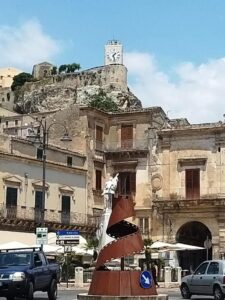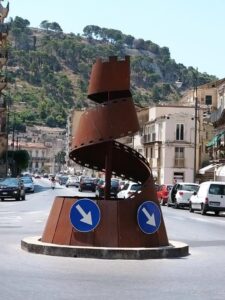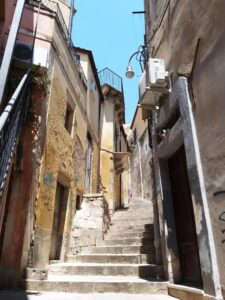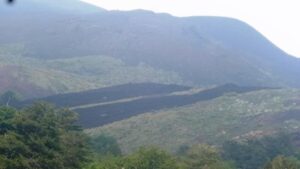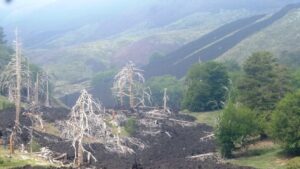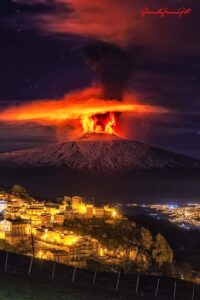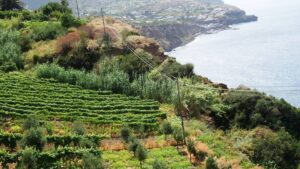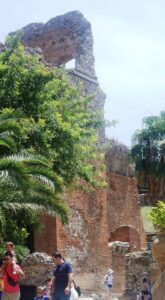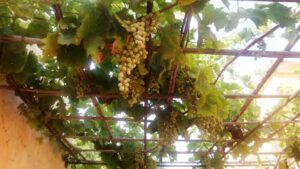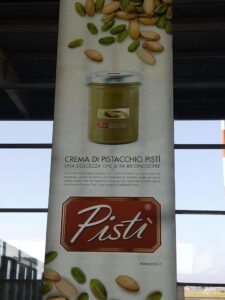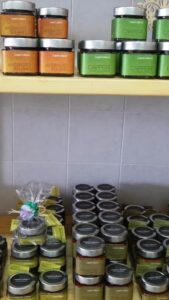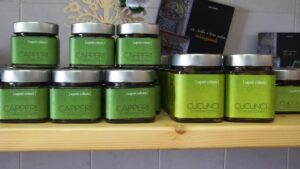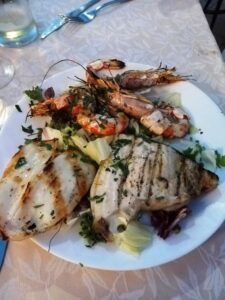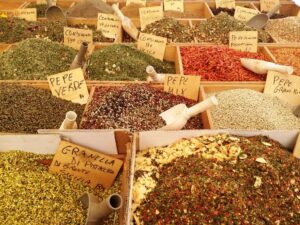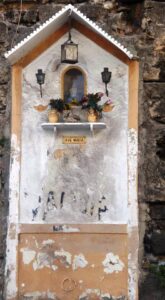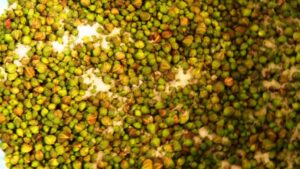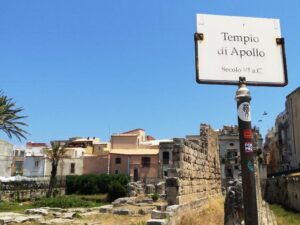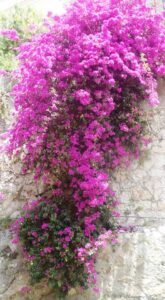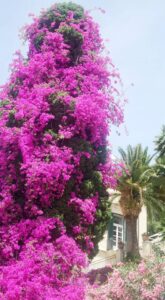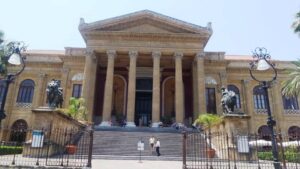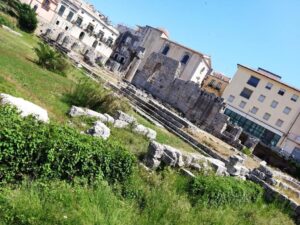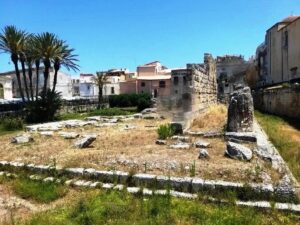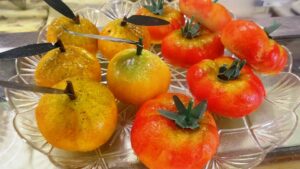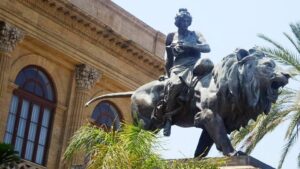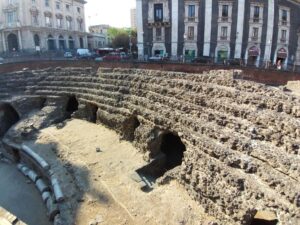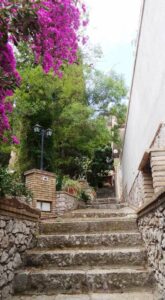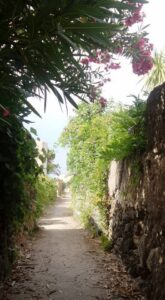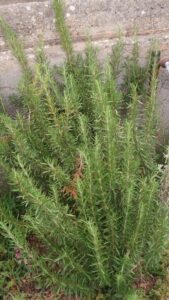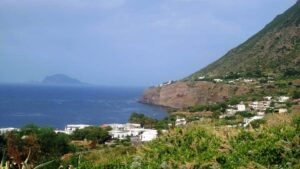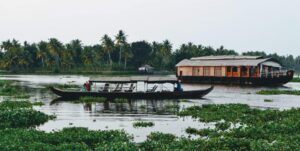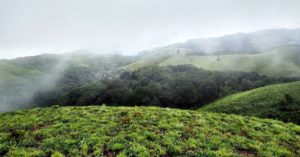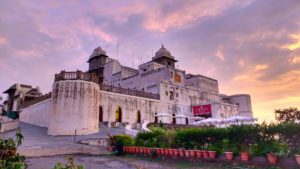Ahh, Sicilia, mia amore…you have my heart!
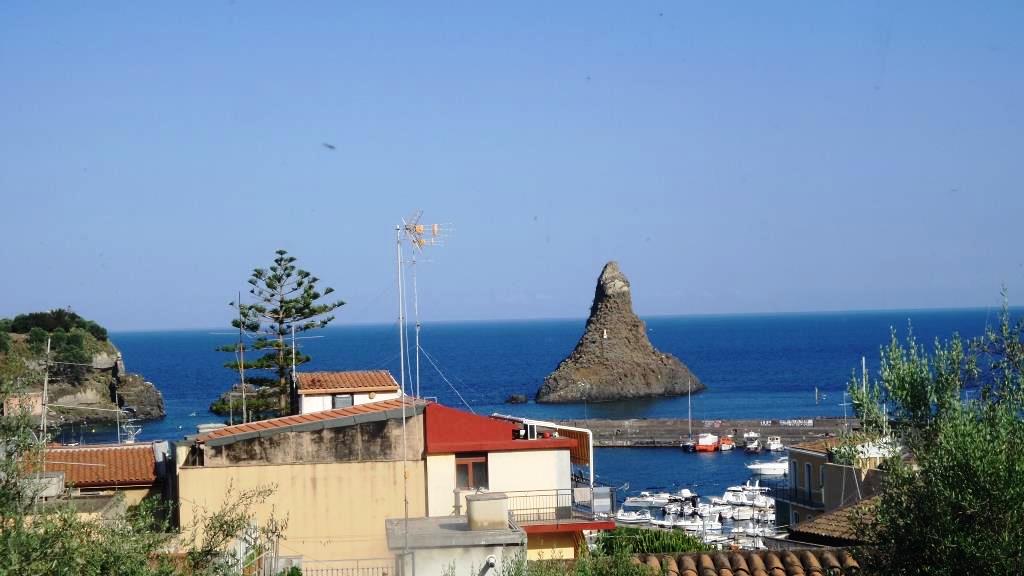
Acireale
Sicily – A Travelogue By Punam Mohandas
Sicily is often called the “boot” of Italy, because it’s so far down south, the very edge of the country. It is one of the most naturally beautiful terrains in the world. Apart from this, it has a rich Roman, Greek Byzantine as well as Moorish influence in terms of its architecture and food.
And, of course, the Mafia made it (in)famous, particularly with its chilling law of “omerta” (silence). I have to confess that I was especially fascinated at the thought of visiting Sicily due to the mafia, promulgated by the ‘Godfather’ series, the books as well as movies and, indeed, I actually did go to the Castello Degli Schiavi (where the famous scene in which Michael’s Sicilian love Appollonia is blown up in a car bomb was shot) in Fiume Freddo.
Once here, I was captivated forever and fell in love with the land all for itself – no reason needed! Sicily is wild and untrammeled with a raw, primal beauty. Almost everywhere you look, profusions of bougainvillea grow unfettered; glorious bursts of riotous colour against a sunshiny day and the blinding blue of the Mediterranean sea…and then the impossibly yellow, orange, red of the bell peppers, luscious cherries, lemons and other fruit, the vivid green of the olives. Sicily is a picturesque land and a curious amalgamation of centuries-old culture, the legacy of various marauding armies.
When you talk about Sicily, apart from its natural spectacular beauty, all one mostly talks about is food, food and food. This tiny island offers some of the most mind-blowing cuisine! Herbs and vegetables are carefully nurtured and the Sicilians use only fresh produce, either from their own farms or that of their friends, to cook their meals. The best olive oil in the world in its most pure and natural state, is from Sicily. The cannoli (crisp, sweet rolls filled with ricotta cheese, mascarpone, etc) originated here, so also the arancini, which are deep-fried rice balls flavoured with saffron and stuffed with delicious mixes such as tomato and eggplant with cheese, or minced beef and cheese and so on. The most famous dessert apart from the cannoli is the granite (akin to sorbet), while the creamy gelato (ice cream) is to die for!
Since I am unashamedly biased about Sicily and can wax lyrical for hours on end, I thought it best to break this travelogue up by mentioning specific places and why they’re each so unique and special. Catania and Palermo are the two main cities and both have international airports, while Milazzo in Messina (the third largest city of Sicily) is one of the most important ports.
Catania
If I had to choose a favourite Sicilian city, then it would be Catania (note that names ending with “a” are feminine, while those ending with an “o” are masculine) by the Ionian Sea and under the forbidding shadow of Mount Etna, not only for its subtlety in flavours, but the friendly people, the lushness of fruit and other produce and the sheer, spellbindingly gorgeous panoramas! Living here is a mixed blessing, though – while an active volcano causes great havoc and destruction, the volcanic ash is most fertile for growing vines and other vegetables! Can you believe that Catania has been buried under Mt Etna’s molten lava at least 17 times in recorded history?! And under all these rebuilt layers somewhere is a Roman city…and then a Greek city that came before! The mind boggles!
What I found most fascinating is how the locals have just built up an entire township around ruins…it is completely natural to find a modern house or a swanky restaurant that has a crumbling wall thousands of years old cheek-by-jowl! Indeed, the town centre has come up around the ruins of the Roman amphitheatre; it is possible to walk around quite freely, with no entrance tickets. I was absolutely awestruck to descend into this and then to climb back up the steps in a time machine rush from history to modernity is so surreal – to be faced with mobile phone shops or a metro station after wandering such ruins.
Not far from the amphitheatre, branching off to the left, is a narrow alley that has not one but five shops run by Bangladeshi immigrants, all selling Indian spices! There is even a Chinese shop along via Rocca Romana! I was fortunate to stay at an apartment not far from the Parco Greco-Romano while studying for a course here; unfortunately, although I anticipated many a pleasant weekend here reading and picnicking, I was warned to be careful as it was frequented by tramps.
Ahh, the food, mamma mia – e molto gustoso (very tasty)! As students on a shoestring budget, Danielle and I were regulars at our corner pizzeria across from our flat on Rocca Romana; for euro 4.50 we got a 12-slice pizza! You get the best arancini in Catania/Taormina (try the pistacchio one at Pasticceria Savia), as also the pasta pistacchio. Pizza pistacchio is something every gourmand should eat at least once in this life – it’s got a creamy, crushed pistacchio sauce layer, cream cheese, fresh basil leaves and whole pistacchio nuts (try at Acido Lattico Umberto). My friends and study mates all used to tease me, saying: “give her anything pistacchio and she’ll stay quiet and happy”! Well, honestly, where I come from, pistacchios are an expensive nut, to be used sparingly in desserts on occasions only and to see it added so casually here as just another ingredient just blew my mind! Gelatos – the best I’ve EVER had are here in Catania (try at Bar Magri) or else, Taormina. As an aside, noting my great love for crime fiction and my fascination with the mafia, some of the naughty guys on the course tortured my imagination by telling me that many of the waiters at Magri and other cafes were, of course, mafia, and would tap a finger to the side of their nose significantly each time a waiter turned to look at our table!
Catania has a small international airport – Fontanarossa – as well as train station and is easily accessible from other European cities.
Mt Etna
Sicily is a mountainous terrain by the sea and also has many active volcanoes, the most famous being Mt Etna, which is the tallest volcano in Europe. It’s about a 40-minute car drive from Catania along winding, narrow mountain roads. Scenes of utter desolation and devastation mark the area; tree skeletons and sadly withered branches forever shorn of leaves stand somehow upright along the angry, vivid black trails down the mountain side from the volcano’s crater. There is a hushed, foreboding atmosphere as I walk around here with my friend Emiliano, who has actually been to the rim of the crater once when Etna was burning red and spewing forth flames! The beaches of nearby Acicastello and Acitrezza have fine, volcanic black sand. Carmen, the lovely lady at my hotel in Acireale (Village of a 100 Churches), told me the locals walk around with umbrellas to protect themselves because when Etna suddenly erupts, the hair and clothes get covered with flying black ash! Indeed, Etna suddenly started spewing on the day I was to leave Catania on my last visit in 2019; from early morning, we could see the smoke signals in the sky and I was just so worried that the flight would be cancelled.
Syracusa
Syracusa – or Siracusa, home of Archimedes – is dry and dusty, replete with ancient Greek and Roman history. I’d been wanting to visit here because my imagination was fired by the thought of seeing an incomplete Apollo temple here…why was it left incomplete? What did a temple dedicated to Apollo the sun god, look like? Of course, there are lots of duomo’s and palazzo’s in Syracuse, but it’s this temple that interested me and so off I went.
The Temple of Apollo is on Ortygia, in front of the Piazza Pancali, now dotted with cafes. It dates to the 6th century and is a mass of broken, moss-covered stone columns. I never did learn why it was left unfinished, or whether someone just used that word many years ago when what they actually meant was “broken”, but I did discover that it was used as a church as well as a mosque, through the ages. At any rate, it is a quite surreal experience picking my way carefully through these broken pillars and slabs…just imagine, people from the 6th century! once walked here!
Walking straight ahead through the piazza I made another discovery – most of the street stalls selling souveniers are owned by Pakistanis! I got chatting with one of them, dressed in his native kurta-pyjama, who said he and his four brothers all have stalls here; they take it in turns to make the annual trip home. Why Sicily and then Syracusa, of all places? I pondered. It’s another way to make a living, he shrugged.
Nothing worth the mention eating here in Syracusa; I had a quick pasta and then made my way back to the bus station.
Taormina
So my friends Antonio and Emiliano, Diletta and Giusy, can’t quite understand the fascination that Taormina holds for me. Perhaps living in the vicinity has inured them to its beauty; of course, I understand that the wave of chattering tourists must dilute much of the charm! Also, of course, they live in areas like Acireale or Fiume Freddo, which offer its own delight and a similar landscape.
However, seeing it through my eyes, Taormina is truly God’s own land. Alighting from the bus, I was absolutely awestruck at the splendour of the vivid blue of the sea, offset by deep magenta bougainvilleas growing wild amid ancient ruins; the typical, tiny, winding alleys leading to the Teatro Greco; home-made gelato shops fighting for attention with Godfather souvenier keychains, mugs and aprons. Yes, Taormina is undoubtedly overrun by tourists (and, appallingly, refugee beggars as I discovered on my last visit), nonetheless, ignore all the human detritus and just focus on the magic of Nature that God has provided for us to revel in.
Honestly, all I did is walk around this amazing place, almost all the way down to Isola Bella, getting heady drunk on its picture-postcard-perfect charm and eating gelatos as the whim took me, so I can’t answer for how great the food is at Taormina; I did, however, enjoy an aperitif and seafood dinner at Isola Bella with Antonio one evening.
Catania has a lot of history, but neither Catania nor the other neighbouring places I’ve mentioned here come close to even rivalling Taormina’s sheer beauty and feminine grace. If there was a rival, I’d pick Ravello on the Amalfi coast.
Giardini Naxos
As the name implies, this fishing village traces its origin to the Greek period; Catania was colonized with Giardini Naxos as the base. I absolutely loved living here and spent an enjoyable few days at a B&B (Gianni House) run by the irrepressible Gianni and his long-suffering wife, Gabriela. Giardini Naxos is about 20-minutes away from Taormina by bus, which, frankly, is its biggest claim to fame; thankfully, it isn’t over-run by tourists. It’s a quiet place where one can go for long, blissful walks along the seaface. There are plenty of small restaurants and pensiones such as Gianni’s around, but nothing outstanding in terms of dishes or desserts. I walked all the way to the local supermarket once, where I bumped into the very friendly, voluble Chiara at the cheese counter. We got chatting of this and that and you could have knocked me down with a feather when she told me the monthly shopping for her family of three came to only 350 euros! I’m not kidding – that trolley cart was piled high with meats, vegetables and of course, about fifteen different types of cheese and olives! Food in Sicily is really quite inexpensive as the people literally live off the lush produce of the land (unless you plan to hit one of those over-priced fancy joints).
Bronte
I was eagerly awaiting my trip to pistacchio county! That’s right – Bronte, about 40-minutes away by car, is famed for its pistacchio groves and, of course, the resultant pesto, gelato, etc. The story goes that Bronte, one of the Cyclops (creatures with only one big, round eye), used to live under Mount Etna, hence the name. My American friend Shaun and his lovely Italian wife Marinella took me along one Saturday morning. Bronte is a small, quiet village nestled among some mountain ranges, blessedly free of tourists. There is a main church as well as castle, but we did neither, as this was a purely gastronomic trip! I have to say that the gelato at Bar Magri in Catania is infinitely superior. Also, the pistacchio pesto is readily available in Catania, so you can skip this trip if you wish.
Modica
If Bronte is pistacchio county, then Modica, about two hours away by bus from Catania, is chocolate county. That’s right – there’s some world famous chocolate from this little town, said to date back to some ancient Aztec recipe, with flavours such as cardamom, saffron, chilli, coffee and pistacchio. It’s dark chocolate, slightly dry and bitter in texture and taste. Modica’s got a couple of notable cathedrals such as San Giorgio and San Pietro – the façade of the latter is particularly stunning. Modica prided itself on being a centre of art and culture; the Nobel Laureate Salvatore Qausimodo is from here. The town is really prettily laid out, with mysterious flights of steps along one wall leading to little squares of sunshine, filled with shops and restaurants along it. Nobody could explain it to me, but I found the idea of a film negative used as a traffic round-about rather quaint.
Salina
To be honest, I had never heard of the Aeolian islands so when Riccardo, the head of the Visit Italy office in Tokyo, excitedly messaged me to say he’d got a stay organized at Salina for me, I was less than enthused at the thought of the involved journey, which entailed travelling from Catania Fontanarossa airport by road to Milazzo, about two hours away and then a hydrofoil to Salina, another 1.5 hours away (I was too chicken to try a chopper ride)!
Salina is like one of those enchanted Enid Blyton places one was so fascinated by in childhood. It is part of seven islands known as the Aeolian Islands, the others being Vulcano, Alicudi, Panarea, Stromboli and Filicudi, with Lipari being the largest and most touristy. Much like Etna, Stromboli is still an active volcano, with frequent eruptions.
I stayed at the very exclusive Hotel Signum in the quite small and extremely tranquil village of Malfa on the island of Salina, with narrow lanes that lead thither and yon. My hostess and the owner, signora Carla, is well respected on Malfa and is also a patron of the arts here. She started the hotel by buying up old houses as they fell either vacant or into disrepair and so the Signum is a series of individual, low-roofed buildings that have come up around a herb garden and vegetable farm, with orange, lemon and olive trees dotted all around the homestead while overhead a canopy of grape vines links the reception building to the spa, with its outdoor swimming pool. Clara travels around the islands eagerly buying up old doors or cabinets that people want to get rid of, lovingly restores them and they find a room (sic!) somewhere on Signum. For instance, my room was simply furnished, with whitewashed, rustic walls and a bed, mirror and window frames that dated back to centuries past! Many of the rooms even have the quaint Sicilian style of doors that come with wooden shutters, where the upper and lower halves can be opened separately.
Clara’s daughter Martina is a Michelin star chef and responsible for the exquisite dishes on the table. The Aeloians are obsessed with and justly proud of, the produce from their land, especially the capers and olives. To be honest, I wasn’t a fan of olives or dipping warm, freshly baked bread in olive oil as an antipasto – sounded great in romantic novels, but I didn’t care for the taste. Clara, who couldn’t quite believe this blasphemy, kept urging me to try some of the Sicilian olive oil. At length, rather than appear rude I decided to appease her and, my goodness, this was truly the ambrosia of the gods! Never before had I tasted such, thick sweet, pure olive oil! Clara just beamed complacently at my expressions of wonder and delight. I’m hooked for life now on Sicilian olive oil and unfailingly carry a large bottle back from my trips!
Walking around Malfa, I noticed one bakery, one butcher’s, one mini supermarket and FIVE gelato shops! Tells you the priorities of the Aeolians here! A couple of old men walked into one, bought their ice cream and then settled down on the benches in the piazza in the sleepy afternoon sunshine. Down below were these majestic sea views…the very air was still. This is a place you come to get in touch with your inner self, your very soul; there is no hustle-bustle on Salina.On my wanders, I was pleasantly surprised to find a small boutique called ‘Shanti’; the owner has travelled to India many times and loves it there, so he stocks a lot of Indian artefacts, Kashmiri shawls, kaftans, etc.
Signora Clara was worried I would get bored and so she requested the kindly Salvatore, who knew only “hello” and “I love you” in English, to show me around Salina. Fortunately, he is married to Australian Libby, who confided their fairytale love story to me as we drove around; apparently, she visited Salina one winter, fell in love with the island as well as the man and kept coming back each successive winter. Libby learnt Italian, so she could converse with the love of her life.
And so this sweet couple took me along winding, scenic mountain roads to Pollara, where the movie ‘Il Postino’ (The Postman) was shot. Malvasia wine from the Aeolian islands is much sought after and we also visited the famous island vineyard, Virgona, owned by the family of the same name. From there, we went to Sapori Eoliani, the caper production unit owned by Salvatore’s son and first wife that exports caper preserves all over the world. (I never did develop a taste for capers). Finally, towards the late, hot afternoon, we wound our way along views of volcanic cliffs to Lingua, to the pretty much world famous Da Alfredo’s for granitas. Finally, tired but oh-so-happy, we arrived at the Signum in time to see a splendid sunset over the islands and relish the feast Martina had cooked up.
While I looked forward to the next leg of my Sicilian adventure – Palormo – it is no secret that I was leaving Salina with a heavy heart.
Palermo
Signora Clara’s extraordinary graciousness and kindness did not end with my leaving Salina. Upon learning I knew nary a soul in Palermo and was just planning to wander around on my own, she semi-scolded me, called up her friend Roberto who is a jewellery designer there and commanded him to be my tour guide and show me around.
And so it came to pass that Roberto arrived at the Ibis Palermo to collect me and take me off to see Palermo Cathedral. As he waited at a roundabout for his turn, he casually mentioned this is where a prominent judge had been gunned down by the mafia a few years ago. Madonna! And then we drove up dusty, narrow roads to Monreale and the Duomo there with its lovely gold mosaics. All along the way, Roberto pointed out groves of almond and orange trees. On the way back, having learned of my great fondness for arancini (in Palermo it’s got the masculine ‘o’ so it’s arancino), we stopped at one of Roberto’s favourite cafes, where I disgraced myself forever by pronouncing the Catanian ones better!
The next day, Roberto had to work, so I was free to wander around the Teatro Massimo and the nearby fruit and vegetable (separate) markets. I spent a very pleasant morning eating cherries and peaches as I wandered around nonchalantly. I found Palermo to be hotter and dustier than Catania. Late afternoon, I wound my way to Roberto’s jewellery store and workshop, where he showed me around and I redeemed myself somewhat in his eyes by telling him the matorana (marzipan) was of infinitely superior quality in Palermo, as compared to Catania. This, by the way, is quite true – there is more of the almond paste and lesser sugar in the Palermo marzipans, besides, they make fantastically real-looking fruit replicas.
And then came the day when I had to end my Sicilian sojourn. The hotel kindly called a cab (you can use shared cabs at 10 euros a head) to take me to Palermo’s Falcone Borcellino international airport one early morning and I headed back to London, filled with memories that would last me a lifetime.
Note: The above travelogue is a loving compilation of trips to Sicily over the recent years…there is still so much to see and experience there. Unfortunately, the COVID put paid to my plans for 2020 and 2021 but 2022, God willing, will see me back in the home of my heart.
Punam Mohandas asserts her right to be identified as the author of this work. Any views or opinions expressed in this review is that of the author. All copyright is the property of the author.
